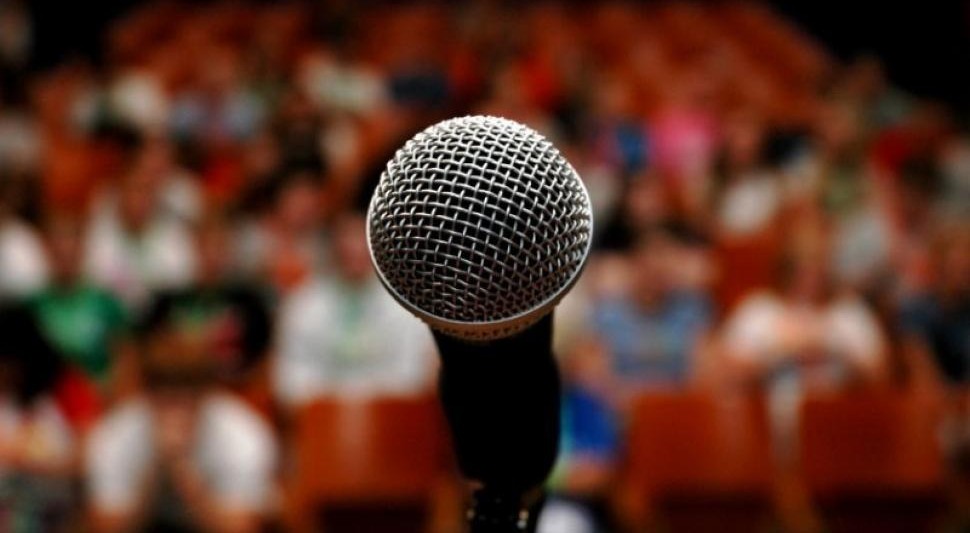14 basic mistakes when presenting in public
Glossophobia is the term used to refer to fear syndrome standing in front of a crowd that many people now have. Not only you but in the world, millions of people still have that inferiority feeling.
According to the National Institute of Psychological Health, up to 74% of people are experiencing fear when presenting a problem to the public. And, as most of us know, when we feel scared or anxious, our minds and bodies tend to "do stupid things", which we don't always control.
However, if the intentional effort is possible, you will avoid some of the basic errors in the presentation that you often get and the following 14 mistakes are some of them.
1. The message is not aimed at the audience
As Benjamin Disraeli once said: "Talk to a man about him, he will listen to you for hours".
On the other hand, if you don't tell the audience about yourself, it's likely, they won't want to hear you talk. This is the affirmation of Darlene Price - chairman of Well Said, and also the author of Well Said! Presentations and Conversations That Get Results . "Speakers often have a bad habit of presenting problems according to very similar things that are not changed to address the problems that listeners are having. People who hear when people are say there is no preparation of the speech before and their reaction will go from frustration to anger and not listening anymore ".

To avoid this mistake, ask yourself: "Who is your audience? What is their most pressing issue? How useful are they to show them? How much do they understand? I will ask them to do something to create a connection? ' All the best lectures depend on this first principle, that is to understand the audience.
2. Move eyes too quickly
From beginners to experienced people, most speakers cannot maintain continuous eye contact gestures that make sense to listeners."Their eyes fluttered unconsciously from one person to another, looking around the room without stopping to really pay attention to the people listening to them." Price said, "lack of eye contact will show a range of attitudes that distract the opponent like: dishonesty, indifference, indifference, lack of confidence, cunning and even arrogance."
For visually connected, eye gestures directed at each person must last at least 2 to 3 seconds or long enough to say a complete sentence / paragraph.Effective eye contact is the most important non-verbal skill in a speaker's "toolbox".
3. Bad gestures distract the listener
There are at least 20 bad habits that need to be eliminated, including: clasping your hands, walking back and forth, putting your hands in your pockets, shocking coins or keys while talking, turning rings on your fingers, standing still on the stage podium, licking her lips, constantly touching her hair or clothes, turning the pen, shaking her head, clasping her hands behind her back and touching her face."Having one or more of these habits can distract your audience from what you say and no longer trust you," Price explained.

Recording what you will say and reviewing them is the solution to help you solve this problem."Practice will often help you relax and reduce anxiety. Also, take a presentation class or take training courses to eliminate these bad habits and create new habits to help you are more confident when speaking ".
4. Lack of energy
"As the world record holder for many successful shows in the same show at the stage Broadwar, George Lee Andrews is famous for the role of Monsieur André in The Phantom of the Opera". Price said. "He certainly felt very tired in at least one or two performances of a total of 9,382 shows that he attended but he never showed it outside. Pay attention to his contract. It is known to be extended 45 times over 23 years. "
Enthusiastic, defined as the excitement and positive interest that the audience wants is most visible at each presentation. On the contrary, conveying boredom with monotone, facial expressions that lack vigor and lethargy are points that listeners are extremely hated at the speakers.
According to Price, to avoid this situation, "please speak with passion, smile in a friendly way, move naturally and enjoy every moment that you communicate with the audience".
5. Do not practice first
Excellent speakers have prepared."In particular, they know the subject to speak, organize content, impressive slide design and thoroughly understand the issues they want to present."
However, according to a recent survey conducted, Price said that less than 2% of the living group of more than 5,000 entrepreneurs present at the Fortune 100 show actually rehearsed their presentations. . This bad habit led to the audience only hearing and not really understanding what was conveyed.
To optimize the listeners' awareness and get the results you want after the presentation, practice speaking out loud at least once before standing on the stage.
6. Confusing content
"This is very easy to understand. After all, our reputation will begin to be judged when we get up and start talking. So, to be safe, we often focus almost entirely on something. Aristotle called Logos including the function of logical reasoning, language, analysis, reason, critical thinking and numbers ".

However, when all the content types are used, the presentation will become lengthy, too many slides are unnecessary and as a result you will have to take the time to read the letters and numbers on the slide without skipping The most important part is focusing on the audience. Price stressed: "Get rid of the habit of using confusing content." Because, you will lose listeners and diminish your innate ability to inspire, connect and persuade.
7. No inspiration
According to Aristotle, even more important than Logos for the persuasive art is Pathos , which includes activities on the right brain such as emotions, images, stories, illustrative examples, empathy, humor. , imagination, color, sound, contact and create relationships.
"A series of studies have shown that specific people are making decisions based on first emotions (Pathos), then we look for facts and numbers to prove it (Logos). Audiences do the same, with your words, pictures and actions, start looking for ways to convey feelings to them (enjoyment, surprise, hope, excitement, love, co-existence) feeling, hurt, sadness, fear, jealousy, sin) Next, give analysis to clarify those feelings ".
A presentation that is imprinting, convincing and connected must have a balance between information and inspiration . "It must be" spoken "with both the head and the heart, with a mix of both facts and emotions."
8. Lack of break
Many speakers that have a bad habit are constantly talking. Like a train running, they accelerated too fast, resulting in a loss of braking, unable to stop and not turning.
The reasons for this condition often stem from anxiety, the body releases too much adrenaline or feels stressed due to limited presentation time. According to Price: "For whatever reason, there are three times when you should have a break, including: before and after saying something important to the audience to remember; before and after the transition from a key point to the next point and between the three parts of the lesson: open the lesson, close the body and conclude.
When using intentional silence as a rhetoric, you will feel more confident, the message conveys a stronger effect and the audience will also remember more than what you say.
9. The beginning is unattractive
" According to Greek philosopher Plato, opening is the most important part of a job." However, "the very common bad habit of speakers is wasting these precious first moments in babbling things of no importance, joking, reading programs or making excuses without All these things cannot attract the listeners and motivate them to listen to you continue. "

You, your message and your audience deserve more.
Therefore, please start with an impressive way. Investing in gray matter, time and effort to sharpen and always remember that opening is "the most important part of the entire presentation". For example, you can tell a touching story, related to the topic you want to say, give an unexpected number or ask an open question to challenge the listener.
10. Use too much (or too little) funny factor
It's hard to determine exactly how much time in a presentation you should use for jokes - especially if you don't know much about the audience.
Obviously, you don't want your talk to be dry and boring, but you don't want to give it as if you're trying hard to be a comedian.
The best rule of thumb here is to be yourself and you can use some humor for reasonable times.
To let the audience laugh (or at least smile) from the beginning the presentation is the best way to break the space of silence, stress and connect faster with them. However, try this kind of joke with friends first to make sure it will create a nice effect.
11. Read the slide
Slide is a useful tool to "remind" you content and reinforce important points for your audience.
However, according to Geoffrey James, an author in Inc Magazine, those who watch your presentation can read it on their own, so they say the right information and images that will make them feel boring and humiliated!
"Using slides as signs for the key points you want to emphasize is better than a soft copy for all you will say."
12. Give excuses or apologize
Maybe you are late and want to tell the audience why. Or maybe you just had a long flight and wanted them to sympathize if the presentation was not as good as expected.
Anyway, giving an excuse or an apology will create a negative tone and make the audience have a reason to think that your talk will not be impressive. Instead, overcome that risk yourself and let the audience self-assess the quality of the presentation.
"No matter how you feel, show your enthusiasm right on the stage and do your best."
13. Continuously showing anxiety - or not acknowledging
One of the worst things you can do is attract unnecessary attention to the fact that you are worried. Repeatedly expressing it - or referring to it many times during the presentation can make the listener feel a bit uncomfortable.

However, you can - and should - acknowledge your lack of confidence once before continuing your presentation.
Research done at Boston University shows that hiding emotions of anxiety with the audience - what they call repression can actually make that fear rise and the heart also beat faster. Obviously, this would be detrimental to the quality of the presentation.
14. End the lesson with Q&A question
You've probably heard a speaker finish a speech that was supposed to be good with a blunt statement: "That's all. Does anyone want to ask a question?".
For the listener, this act is like a firework with a detonator that has been exposed to water that is often called a "spray bomb". According to Price: "Your best ending is the last chance to consolidate important issues, ensuring that the message will be remembered and stimulated by the audience." Avoid the habit of ending the Q&A-style question because it will make what you have presented without leaving a mark.
It doesn't matter if you invite the audience to ask questions and make comments. However, make sure you have a very strong end: "Finish the topic with the following three sections: summarize the brief content, make a call to action and a perfect sentence. Build the habit of saying the last sentence you want the audience to remember most ".
You should read it
- Voice in communication and how to have a good voice?
- 10 ways to make a good impression right from the first meeting
- 7 body language helps you to sympathize with the opposite
- 7 indispensable gesture languages for a professional manager
- Changing these 10 ways of speaking will help you advance like 'windy kites'.
- The secret to developing children's speaking skills
- Shadowing Technique: Practice speaking English effectively without having to go to the center
- How smart people behave?
May be interested
- Basic errors to avoid when doing gym
 everyone knows the benefits of the gym, but not everyone knows how to practice correctly even with basic movements. actions such as pushing, squatting, lifting weights, sagging, ... seem simple but very easy to make mistakes while practicing.
everyone knows the benefits of the gym, but not everyone knows how to practice correctly even with basic movements. actions such as pushing, squatting, lifting weights, sagging, ... seem simple but very easy to make mistakes while practicing. - The biggest time wasting cleaning mistakes
 https://www.realsimple.com/cleaning-mistakes-that-waste-time-8787442
https://www.realsimple.com/cleaning-mistakes-that-waste-time-8787442 - 7 security mistakes you often make
 although revolutionary, the ease and convenience of disseminating information online also lurks some security threats. many people have unknowingly engaged in risky online activities.
although revolutionary, the ease and convenience of disseminating information online also lurks some security threats. many people have unknowingly engaged in risky online activities. - IOS 13 Public beta 1 with iOS 12.3.1
 after apple released ios 13 public beta 1 update to all users, youtube channel iapplebytes conducted a number of basic-to-advanced tests to compare the speed with ios 12.3.1.
after apple released ios 13 public beta 1 update to all users, youtube channel iapplebytes conducted a number of basic-to-advanced tests to compare the speed with ios 12.3.1. - Mistakes to avoid when implementing SEO
 in the process of making seo, when you make some mistakes that will make it difficult for the webiste to appear in the search results, let alone stand in high rankings. therefore, it is necessary to limit mistakes ...
in the process of making seo, when you make some mistakes that will make it difficult for the webiste to appear in the search results, let alone stand in high rankings. therefore, it is necessary to limit mistakes ... - How to create the index on the bottom, write the exponent in Word
 creating an upper, lower or exponential index in word is a basic operation when presenting content in word, especially when presenting math or chemistry content.
creating an upper, lower or exponential index in word is a basic operation when presenting content in word, especially when presenting math or chemistry content. - 5 mistakes in the past can be corrected from today
 have you ever wished that you could go back in time to fix the mistake? of course, we all know that it is impossible. here are 5 mistakes in the past that can be fixed today.
have you ever wished that you could go back in time to fix the mistake? of course, we all know that it is impossible. here are 5 mistakes in the past that can be fixed today. - 10 Important Mistakes to Avoid When Maintaining Your Computer
 pc maintenance is essential for long-term, efficient performance. however, there are some mistakes you can make that can do more harm than good to your pc.
pc maintenance is essential for long-term, efficient performance. however, there are some mistakes you can make that can do more harm than good to your pc. - Download and experience iOS 11.4 Public beta is more stable than Developer version, and has AirPlay 2
 immediately after the release of ios 11.4 beta for developers, apple has released a version for users who are participating in public beta.
immediately after the release of ios 11.4 beta for developers, apple has released a version for users who are participating in public beta. - 7 reasons why never making mistakes is the biggest mistake
 fear is just nothingness, no gain and no one should be much bigger than the fear of making mistakes. here are 7 reasons why never making mistakes is the biggest mistake you can make.
fear is just nothingness, no gain and no one should be much bigger than the fear of making mistakes. here are 7 reasons why never making mistakes is the biggest mistake you can make.










 9 ways to remove wrinkles on clothes without using irons
9 ways to remove wrinkles on clothes without using irons 8 lessons on the leadership of Facebook's human resources director for young managers
8 lessons on the leadership of Facebook's human resources director for young managers 18 tricky tricks for clothes to save you some money
18 tricky tricks for clothes to save you some money 8 mistakes should be avoided when writing a CV
8 mistakes should be avoided when writing a CV According to Google, this is the key of an effective working group
According to Google, this is the key of an effective working group 3 tips to help startups overcome the turbulent early stages
3 tips to help startups overcome the turbulent early stages